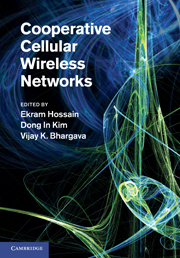Book contents
- Frontmatter
- Contents
- List of contributors
- Preface
- Part I Introduction
- 1 Network architectures and research issues in cooperative cellular wireless networks
- 2 Cooperative communications in OFDM and MIMO cellular relay networks: issues and approaches
- Part II Cooperative base station techniques
- Part III Relay-based cooperative cellular wireless networks
- Part IV Game theoretic models for cooperative cellular wireless networks
- Part V Standardization activities
- Index
1 - Network architectures and research issues in cooperative cellular wireless networks
from Part I - Introduction
Published online by Cambridge University Press: 03 May 2011
- Frontmatter
- Contents
- List of contributors
- Preface
- Part I Introduction
- 1 Network architectures and research issues in cooperative cellular wireless networks
- 2 Cooperative communications in OFDM and MIMO cellular relay networks: issues and approaches
- Part II Cooperative base station techniques
- Part III Relay-based cooperative cellular wireless networks
- Part IV Game theoretic models for cooperative cellular wireless networks
- Part V Standardization activities
- Index
Summary
Introduction
The systematic study of relaying and cooperation in the context of digital communication goes back to the work of Van der Meulen and Cover and El Gamal. The basic relay channel of consists of a source, a destination, and a relay node. The system models in are either discrete memoryless channels (DMC), or continuous-valued channels which are characterized by constant (nonrandom) links and additive white Gaussian noise.
The study of cooperative wireless communication is a more recent activity that started in the late 1990s, and since then has seen explosive growth in many directions. Our focus is specifically on aspects of cooperative communication related to cellular radio. Aside from the fading model, the defining aspects of a cellular system are base stations that are connected to an infrastructure known as the backhaul, which has a much higher capacity and better reliability than the wireless links. The endpoints of the system are mobiles that operate subject to energy constraints (battery) as well as constraints driven by the physical size of the device that lead to bounds on computational complexity and the number of antennas, among other considerations. There are multiple mobiles in each cell as well as frequency reuse, leading to intracell interference and intercell interference, respectively. The exponential path-loss laws lead to significant variations in signal power at various points in the cell.
- Type
- Chapter
- Information
- Cooperative Cellular Wireless Networks , pp. 3 - 12Publisher: Cambridge University PressPrint publication year: 2011
- 1
- Cited by



